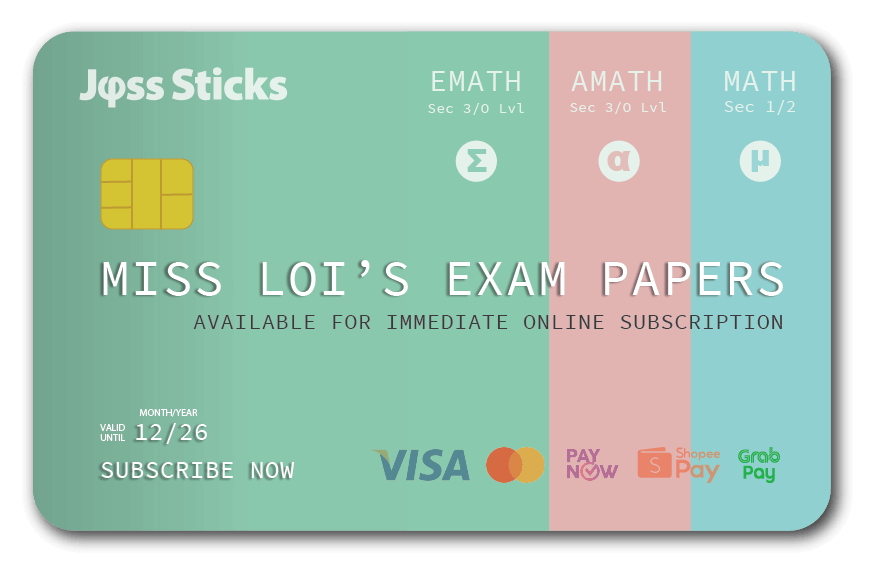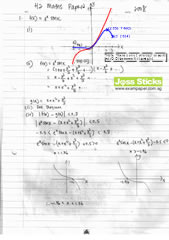Hello everyone – it’s me again.
Hope all of you have done well for your A-Level Mathematics exams.
Sorry for the delay with the 2008 H2 Maths Paper 2 solutions as I’ve been busy with tuition (yes I teach other subjects besides A-Level Mathematics) for the past two days. A problematic scanner didn’t help things much.
Anyway here it is:
As per the 2008 H2 Maths Paper 1 answers, please check if they tally with your solutions and inform me (gently) in the comments below if you discover any mistake or disagree with any of the answers described within.
All the best for your remaining subjects this week!
P.S. I’ve just realised that the silly baseball cap is still there …






 Miss Loi is a full-time private tutor in Singapore specializing in O-Level Maths tuition. Her life’s calling is to eradicate the terrifying LMBFH Syndrome off the face of this planet. For over years she has been a savior to countless students …
Miss Loi is a full-time private tutor in Singapore specializing in O-Level Maths tuition. Her life’s calling is to eradicate the terrifying LMBFH Syndrome off the face of this planet. For over years she has been a savior to countless students … 





















35 Comments
曜
日
8(i) rong
曜
日
Hi. I don't know I remember wrongly, but for Question 1(iv), should it be equal to 0.5 as well? Thanks.
曜
日
ehs........theres a lot of ans tts wrong. p-value is wrong! for 1iv) the inequality should be inclusive. 4iv) ans should be in exact form. is 8iv) wrong cos i dont rmbr getting the ans... lol or am i wrong?? for q1i) they nv say must draw y=g(x) within the domain of f(x) wat... if i draw more than 3 and -3 should not be penalised right?
曜
日
btw to someone, 8i) is actually correct...
曜
日
hello!
for Q5, isn't it a use of T-test instead of Z-test since population variance is unknown and sample size is small? so p=0.121?
and Q8, i don't know why but for (iv) i've got t=1.42+4.40lnx instead so in (v) my t value is 8.32. I tried redoing it but I still got that. Maybe you'd like to double check or let me know how you derive that?
Thanks = )
曜
日
question 4iv) should be in exact solution?
曜
日
to joanna :
Q5 is z-test because the sample is already normally distributed, so you gotta use z-test anyways
Q8 i would agree with u.
曜
日
hi mr Loi, I'm jus wondering for the last question, if i had added the constant (b) to the variance, but the rest of my methods are correct, how many marks will I get penalised?
曜
日
hey mr loi, seem to me that for the f(x) graph there is abit of bending down towards the last part as checked from gc .. and for complex angles isnt it equate p5 to any real positive value like 1 ? i go for t-test too since sample size is small and pop var unknown =))
曜
日
hi i think the graph of g(x) and f(x) shouldn't exactly intersect as the only point of intersection is only at x=0, y=0. if you zoom in your gc you will also find that there is only 1 point of intersection yup
曜
日
y 8(i) correct if u remove the 1st data the r is larger isnt it beta n the graph u drew din curve down in q1 q5 is rong too
曜
日
Hi, the hypo testing should use t test. ans for 4(iv) should be exact, 8 (iv) & (v) seem to be wrong
曜
日
8(iii) i meant if u take away the 1st data, the r is actually larger. u can draw the line for a beta guage
曜
日
just wonder, is there error carried forward for the A levels?
曜
日
hello, is paper 2 qns 8 iv correct? i got t=1.42+4.40lnx actually. or am i wrong ): and 4iv, in exact form should get something like, (9+√13) / 2 ?
曜
日
Thanks again for your feedback and contribution.
I've quickly made the necessary amendments to following parts of the questions in the pdf file that I've overlooked when I churn out the solutions late last night:
Qn 6 - A t-test should be performed since the sample size is small (n < 30), as highlighted by joanna and hi.
toby: A t-distribution models the behaviour more accurately for n < 30. As such, the Normal Distribution should only be used in the case when n ≥ 30, whereby the difference between the t-distribution and the Normal Distribution is negligible.
I hope this will clear your doubts regarding the main amendments to the suggested solutions. I will come back later to discuss the rest of the points raised here when I'm done with tuition later today.
曜
日
thank you Mr Loi.
because i learnt that, in any case if its normally distributed, Z-test has to be used.
so i would like to clarify whether i had learnt is true?
曜
日
oh, variance is unknown in this case, phew!
sorry for the trouble!
曜
日
hi mr loi, just wondering is a low 80+ overall for both papers guarantee one an A grade?
曜
日
Q1(i) y=f(x) has a max turning pt when x =2.356
Q1(iv) qn asking for SET of values so ans shld be presented in set notation
曜
日
@stomp1111 hth will he know when he ain't the one marking the papers? please wake up your idea
曜
日
Do any of you know if there is any websites which have solutions to papers of other subjects like Chemistry?
曜
日
Hi Mr Loi,
For question 1iv), I have initially interpreted the question as your answer did, but shouldn't it mean:
f(x)-0.5f(x)<g(x)<f(x)+0.5f(x)?
not sure how many of you guys intrepret it this way, please let me know guys!
oh Mr Loi, I would appreciate if you can email me so it would be good if I could show you my working or something
Good luck for chem p2 for those taking it tmr!
曜
日
yeah i can see some very unappreciative pple complaining that the answer is wrong blah blah blah
曜
日
Hello again everyone.
Some changes to the pdf file for Qn 1,
Added the turning point for f(x). I replotted the graphs for Qn 1 on my GC last night and discovered that I have accidentally substituted x=3 into g(x), hence the absence of the turning point mentioned by kiA.
Thanks to stomp1111's contribution, I've also adjusted the graphs and highlighted that f(x) and g(x) intersects only at (0, 0). This can be verified in your GC via plotting [f(x) - g(x)], and thereafter performing a TRACE for x = 0.
Now to address some of your questions ...
someone: Your comments are moved here since you're referring to Paper 2.
The data set given in 8(i) is by itself logarithmic in nature. If the 5th data point is removed and x is replaced by ln x (as required in 8(iv)), we'll have a regression line with a nearly perfect r value of 0.999.
While we may also obtain a high r value if we remove the 1st data point, we are not actually obtaining the best regression line for the given logarithmic data set.
ycboy: As for qn 1(iv), it asks for the set of values "within ±0.5". If 0.5 is to be included, they probably would've phrased it as "within ±0.5 inclusively".
randomm: Your comments are moved here since you're referring to Paper 2.
Qn 1(iii) asks for g(x) to be drawn on the same diagram as 1(i) which is the domain of f(x) ⇒ g(x) should follow the domain of f(x) i.e. -3 ≤ x ≤ 3.
Whether it's acceptable for your sketch to go beyond -3 ≤ x ≤ 3 will depend on whether this is included in the mark scheme for this paper. But since the sketch of g(x) carries only 1 mark, I doubt that it matters.
kid: In qn 1(iv), we're interested in the validity range of approximating the non-polynomial function f(x) using a polynomial function g(x).
In this case, we're asked to find the set of values of x so that g(x) is within the error of ±0.5 of the value f(x) i.e.
f(x)-0.5 < g(x) < f(x)+0.5
⇒ -0.5 < g(x)-f(x) < 0.5
⇒ | g(x)-f(x) | < 0.5 ⇔ | f(x)-g(x) | < 0.5
For f(x)-0.5f(x) < g(x) < f(x)+0.5f(x), you're instead approximating g(x) between 0.5 and 1.5 times the value of f(x), which is different.
kiA: The set of values of x refers to the range of x. The question didn't specify that the answer be presented in set notation.
hi: In qn 3(a), for p5 to be real and positive, two conditions must be satisfied:
Equating p5 to a real positive value only ensures that it has a real positive part, but it does not necessarily imply that its imaginary part is zero.
曜
日
rofl, i believed the marks are fixed once u hand in the paper, so i doubt mr or ms loi can do anything to it too. Why not stop postin lame comments here to irritate mr/ms loi and focus on ur other subjects instead? :/ P.S. Thanks fr the ans anw.
曜
日
Hi Mr Loi, is qsn 4 correct? The graph I got from GC shows a bending down portion for both graphs f(x) and f-1(x)
曜
日
The title is misleading. I suggest changing it to "SUGGESTED" solutions rather then not mentioning "SUGGESTED". This solutions are not the official one and it's done by just another person so I do not see why the word suggested shouldn't be added as it may cause other people to think it is indeed the actual and official answer & solutions marking scheme Cambridge markers use to mark.
Even TYS also will state it is just "suggested" solutions. Please change Ty
曜
日
Alright time for more replies ...
Joe: For what range of x is your GC displaying a 'bending down portion' for f and f-1?
I've reproduced below the plots for Qn 4 for f (for x > 4) and f-1 (its reflection about the line y = x)
As you're probably aware, since f(x) is a quadratic curve, there will not exist another turning point for x > 4. The same goes for f-1(x) for y > 4.
曜
日
To brendan, james101, and all who might be curious about how marks are awarded, here's what I've found from a 2006 UCLES A-Level Mathematics Mark Scheme (though I cannot be 100% sure if this will be followed for your just-concluded H1/H2 maths papers):
You can browse around for more past years' A-Level maths mark schemes here.
曜
日
hey thanks a lot mr loi for the answers :)! but one more question: "As for qn 1(iv), it asks for the set of values “within ±0.5″. If 0.5 is to be included, they probably would’ve phrased it as “within ±0.5 inclusively“.". then shouldnt they phrased it as within + and - 5 exclusively? lol? i think cambridge should accept both answers!
曜
日
Hi,
For P2/Q3(b)(i), the required region should rightfully be the line segment within the circle including the 2 end-points on the circle.
Thanks for the suggested solutions!
Cheers,
Wen Shih
曜
日
randomm: Can't say that you're wrong there ... if only the question was phrased clearly from the start. Sigh.
Thanks Wen Shih.
I've highlighted in the diagram for Qn 3(b)(i) the relevant line segment which you've indicated to make the solution more obvious.
曜
日
hi i think the p-value for qn6 is wrong. i got 0.275.
曜
日
oh sorry it's correct.